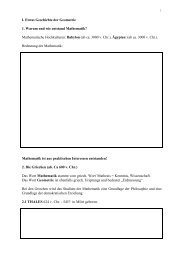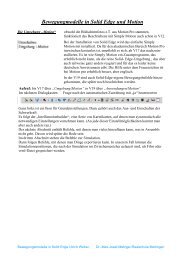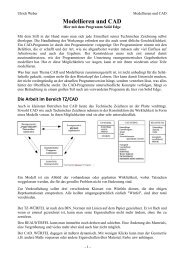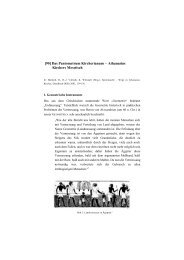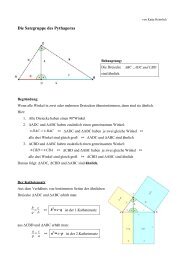Isabelle Hetzler könnte man einmal einladen - Lehrstuhl für Didaktik ...
Isabelle Hetzler könnte man einmal einladen - Lehrstuhl für Didaktik ...
Isabelle Hetzler könnte man einmal einladen - Lehrstuhl für Didaktik ...
Sie wollen auch ein ePaper? Erhöhen Sie die Reichweite Ihrer Titel.
YUMPU macht aus Druck-PDFs automatisch weboptimierte ePaper, die Google liebt.
0.003<br />
0.002<br />
0.001<br />
-0.15 -0.1 -0.05 0.05 0.1 0.15 -0.04 -0.02 0.02 0.04<br />
-0.001<br />
-0.002<br />
-0.003<br />
0.00006<br />
0.00004<br />
0.00002<br />
-0.01 -0.005 0.005 0.01 -0.001 -0.0005 0.0005 0.001<br />
-0.00002<br />
-0.00004<br />
2. Üblicherweise stellt <strong>man</strong> sich differenzierbare Funktionen mit strikten lokalen Minima so<br />
vor, dass sie in einem gewissen Intervall links von der Minimalstelle streng monoton fallen<br />
und in einem gewissen Intervall rechts davon streng monoton steigen. Man zeige, dass diese<br />
Vorstellung durch die Funktion<br />
f(x) :=<br />
� 2 x � 2+sin1 �<br />
x<br />
<strong>für</strong> x ∈ R \{0} ,<br />
0 <strong>für</strong> x =0.<br />
widerlegt wird.<br />
Lösung: Wegen 2+sin1 ≥ 1 <strong>für</strong> alle x �= 0ist<br />
x<br />
f(x) ≥ x 2 > 0=f(0) <strong>für</strong> alle x �= 0,<br />
so dass f in x =0ein striktes lokales (sogar globales) Minimum besitzt.<br />
Klar ist, dass f differenzierbar auf R \{0} ist, und aus der Produkt- und Kettenregel folgt<br />
f ′ �<br />
(x) =2x · 2+sin 1<br />
�<br />
+ x<br />
x<br />
2 · cos 1<br />
x ·<br />
�<br />
− 1<br />
x2 � �<br />
=2x · 2+sin 1<br />
�<br />
− cos<br />
x<br />
1<br />
x<br />
Aber auch in x =0ist f differenzierbar; es ist nämlich<br />
<strong>für</strong> alle x �= 0.<br />
�<br />
f(x) − f(0)<br />
= x · 2+sin<br />
x − 0<br />
1<br />
�<br />
x<br />
<strong>für</strong> alle x �= 0,<br />
und hierbei ist stets � �2+sin1 �<br />
� ≤ 3, so dass der Grenzwert<br />
x<br />
f(x) − f(0)<br />
lim<br />
=0<br />
x→0 x − 0<br />
existiert. Definitionsgemäß ist daher f ′ (0) = 0. Insgesamt ist f also differenzierbar auf R<br />
mit<br />
f ′ � � �<br />
1<br />
1<br />
2x · 2+sin − cos<br />
(x) =<br />
x<br />
x<br />
0<br />
<strong>für</strong> alle x �= 0<br />
.<br />
<strong>für</strong> x =0<br />
0.0004<br />
0.0002<br />
-0.0002<br />
-0.0004<br />
1·10 -6<br />
5·10 -7<br />
-5·10 -7<br />
-1·10 -6<br />
49


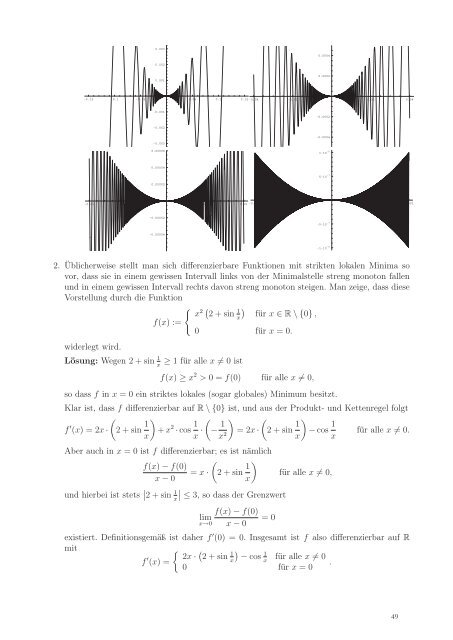

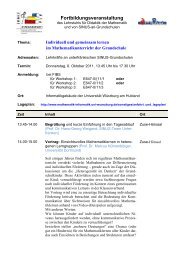
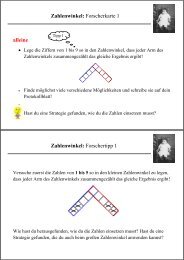
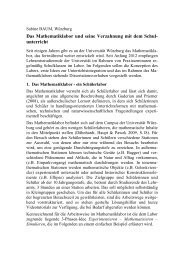

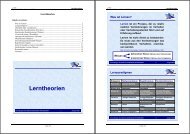
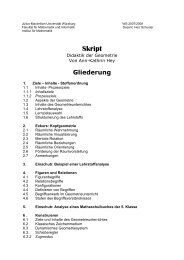
![[91] Das Organum mathematicum – Ein Lehrmittel des Barock](https://img.yumpu.com/8117702/1/184x260/91-das-organum-mathematicum-ein-lehrmittel-des-barock.jpg?quality=85)

